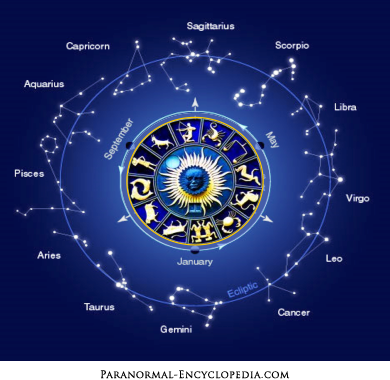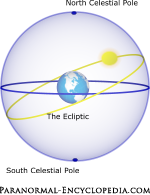Zodiac
“But in the midst of all stands the sun. For who could in this most beautiful temple place
this lamp in another or better place than that from which it can at the same time
illuminate the whole?”
Nicolas Copernicus (1473-1543)3

The Celestial Sphere
Astrology interprets the positions of celestial bodies and applies them to life on Earth. In 1507, Copernicus proposed the theory that the Sun, not the Earth, was the center of the Solar System.
Until the Copernicus Theory was accepted, astronomers, who were actually the first astrologers, believed that the universe was both finite, instead of infinite, and that what we now call the Solar System, was geocentric or earth-centered instead of sun-centered1. They believed that the Universe was a celestial sphere with the Earth at its center. As seen from the Earth, the Sun appeared to make a giant orbit, also called the Celestial Circle, around the celestial sphere traveling through the stars and the planets over the course of a year15.
The Ecliptic

The virtual plane from the Earth to the sun, as the Sun appears to travel along the Celestial Circle, is called the ecliptic and accounts for the formation of the zodiac. During the vernal (spring) and autumnal equinoxes, the Earth intersects the Celestial Circle. The zodiac is based on the apparent positions of the Sun, Moon, planets and stellar constellations as seen from the Earth.
The zodiac divides the ecliptic into twelve equal sections of about 30° each, beginning when the Earth intersects the celestial circle during the vernal equinox. These signs of the zodiac are named after the constellations encompassed in each section and are called "sun signs" or "star signs". An individual's sign is determined by the location of the Sun in relation to the zodiac at the time of his or her birth (see diagram). Each sign represents basic human drives and a set of human characteristics2.
In addition to associating the signs of the zodiac with a season, astrologers associate the
zodiac with the basic elements of fire, air, water, and earth symbolizing their qualities of
heat, cold, dryness and moisture in varying proportions11.
2. Doris A. Hebel. “Astrology.” Microsoft® Encarta® Online Encyclopedia. 2008. 30 Jun 2008 <http://encarta.msn.com/encyclopedia_761552380/Astrology.html>.
3. Bruce Scofield. “Were They Astrologers?.” Mountain Astrologer Sep 1998. 30 Jun 2008 <http://www.mountainastrologer.com/standards/editor%27s%20choice/articles/science_ast.html>
4. LOUIS JACOBS. "Zodiac." A Concise Companion to the Jewish Religion. 1999. HighBeam Research. 5 Apr. 2009 <http://www.highbeam.com>.
5. "Pisces." The Columbia Encyclopedia, Sixth Edition. 2008. HighBeam Research. 5 Apr. 2009 <http://www.highbeam.com>.
6. "Capricornus." World Encyclopedia. 2005. HighBeam Research. 8 Apr. 2009 <http://www.highbeam.com>.
7. "Cancer"--"moon child"--"Sagittarius." The Oxford American College Dictionary. 2009. HighBeam Research. 8 Apr. 2009 <http://www.highbeam.com>.
8. ELIZABETH KNOWLES. "Aquarius"--"Aries"-- "Capricorn" "Gemini" "Leo" "Sagittarius" "Taurus" "Virgo" "Zodiac." The Oxford Dictionary of Phrase and Fable. Oxford University Press. 2006. HighBeam Research. 8 Apr. 2009 <http://www.highbeam.com>.
9. Antony Lewis. "zodiac" Wordwebpro. 2008. 9 Apr. 2009
11. COLIN BLAKEMORE and SHELIA JENNETT. "astrology." The Oxford Companion to the Body. Oxford University Press. 2001. HighBeam Research. 10 Apr. 2009 <http://www.highbeam.com>.
12. "Zeus." Myths and Legends of the World. Macmillan Reference, USA. 2001. HighBeam Research. 11 Apr. 2009 <http://www.highbeam.com>.
13. "Arian"-- "Capricornian"-- "ecliptic"-- "Geminian"-- "Libran"-- "Sagittarean"-- "Taurean"-- "Virgo". The American Heritage® Dictionary of the English Language, Fourth Edition. Houghton Mifflin Company, 2004. Answers.com 11 Apr. 2009. <http://www.answers.com/topic/geminian>
14. "Leo" "Nemean Lion" The Columbia Electronic Encyclopedia, Sixth Edition. Columbia University Press., 2003. Answers.com 11 Apr. 2009. <http://www.answers.com/>
15. "ecliptic"--"Leo"-- "Libra"--"Pisces"-- "Scorpio." Britannica Concise Encyclopedia. Encyclopædia Britannica, Inc., 2006. Answers.com 11 Apr. 2009. <http://www.answers.com/topic/leo-1>
16. "Aquarius"-- "Scorpius." McGraw-Hill Encyclopedia of Science and Technology. The McGraw-Hill Companies, Inc., 2005. Answers.com 11 Apr. 2009. http://www.answers.com/topic/scorpius
17. PATRICK HANKS, KATE HARDCASTLE, and FLAVIA HODGES. "Meena." A Dictionary of First Names. Oxford University Press. 2006. HighBeam Research. 8 Apr. 2009 <http://www.highbeam.com>.
